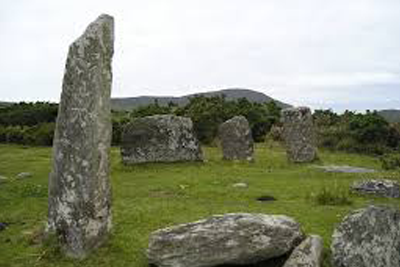🪨 Key Types of Ancient Irish Stone Circles
Stone circles in Ireland are among the most enigmatic and awe-inspiring monuments of prehistoric Europe. Built mainly during the Bronze Age (c. 2500–500 BC), their true purpose is still debated, though most agree they served ceremonial, astronomical, or funerary roles. Here’s a guide to the primary types and where to see them:
🌄 Recumbent Stone Circles
These circles feature a large horizontal stone (the “recumbent”) flanked by upright portal stones, often aligned with celestial events like the moonrise or solstice.
Example: Drombeg Stone Circle, Co. Cork – one of Ireland’s best-known circles, also known as “The Druid’s Altar,” with 17 standing stones and panoramic coastal views.
🌓 Axial or Cork–Kerry Stone Circles
Found predominantly in the southwest, these typically contain an odd number of stones, including a distinctive axial stone set on the southwest side, often aligned with the setting sun.
Example: Uragh Stone Circle, Co. Kerry – a mystical 5-stone circle set between two lakes in a remote valley on the Beara Peninsula.
🏺 Multiple-Stone Circles (Large Ritual Enclosures)
Larger than most, these consist of 20–40+ stones, often thought to mark ritual or gathering spaces. Some are accompanied by cairns or central burial pits.
Example: Beltany Stone Circle, Co. Donegal – a massive 64-stone circle likely tied to seasonal festivals such as Beltane, offering sweeping views of the surrounding countryside.
🕳️ Circle with Central Features (Cairns or Standing Stones)
Some circles enclose additional features like central standing stones, stone-lined graves, or small cairns—indicating possible use for burial or ancestral rites.
Example: Bohonagh Stone Circle, Co. Cork – a classic Cork–Kerry circle with an associated boulder burial and cup-marked stones.
🧭 Solstice-Aligned Circles
A select number of stone circles appear to be aligned with the summer or winter solstice, indicating deep astronomical understanding among Ireland’s Bronze Age builders.
Example: Grange Stone Circle, Co. Limerick – the largest stone circle in Ireland, consisting of 113 stones and aligned with the rising sun at the summer solstice.
Let me know if you’d like:
- A map layer of these sites with GPS pins
- A downloadable travel sheet for heritage tours
- Or to expand this with aerial photos and archaeological insights for educational content or blog SEO

